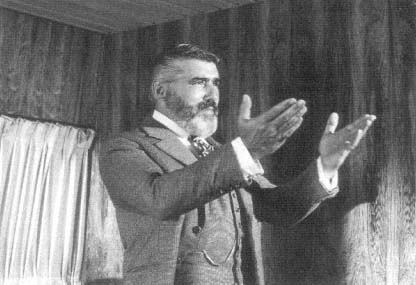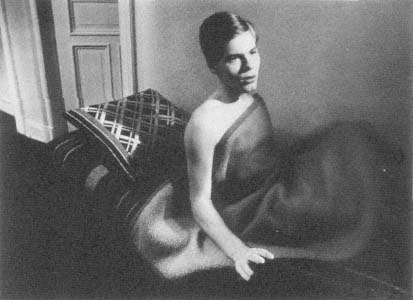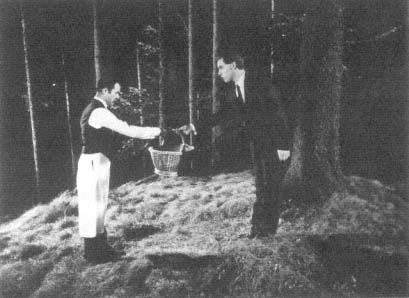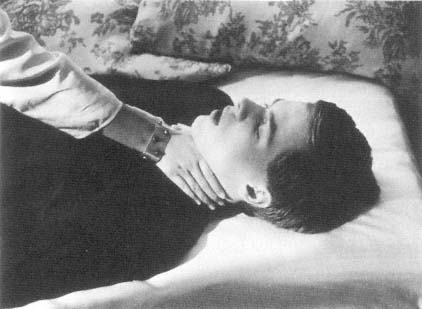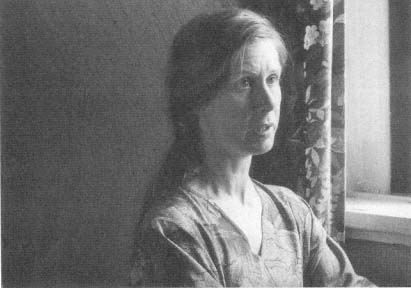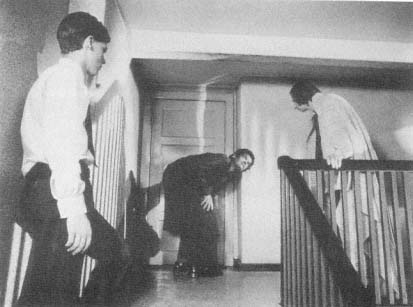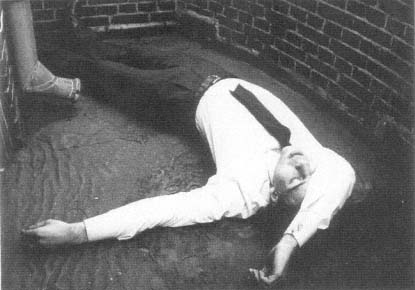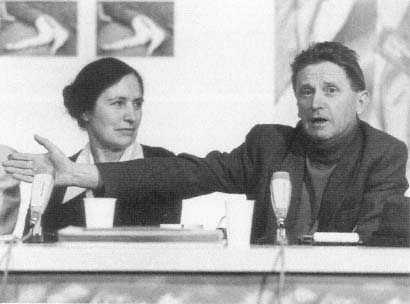8—
The Power to Narrate:
Class Relations and Kafka's Amerika
The utopian force to be found in countering the "patriarchal orchestration of the look"[1] can be found in Straub/Huillet's film Class Relations (Klassenverhältnisse , 1983), based on the novel fragment Amerika by Franz Kafka. Unlike the films before and after it, Class Relations was widely admired by the critics, who called it perhaps their best film[2] and "probably . . . the only Kafka film that can stand the test of time."[3] It prompted the second of two mainstream film books on Straub/Huillet to be published in West Germany.[4] It was also the last of their films to be seen by sizable U.S. audiences (only The Death of Empedocles has been distributed in the United States since), as it was the last of their films to be shown at the New York Film Festival. It was an official German entry at the Berlin Film Festival, where Straub/Huillet were awarded an Honorable Mention "in recognition of their unique, sustained contribution to universal film art." The festival scheduled the film in the afternoon, however, reflecting the official segregation between "art films" and the mainstream. Straub expressed regret that the film thus missed the time when people ordinarily go to the movies but added that it may be an honor to join the films from the Third World in the same fate.[5]
As a black-and-white film photographed with artificial lighting by William Lubtchansky and based on a text of German prose, Class Relations reconnects with the style of the Böll films. Straub/Huillet compare the uncle to Machorka-Muff, for instance, and where the general's conquest of the capital is compared to Fritz Lang's M , Karl Rossmann's journey across America becomes the "journey into the land of vampires."[6] The text, broken into blocks of dialogue, is articulated with syncopated pauses and a range of speech registers again reminiscent of Schoenberg.[7]
Partly funded by the city of Hamburg, Class Relations was rehearsed and filmed there while Straub/Huillet were the city's guests as artists-in-residence. A Hamburg laboratory processed the film, and it was edited partly as an educational project with students at the Hamburg film school. With the exceptions of the final shots, then, the film parallels Kafka's description of America as being all too reminiscent of the oppressions of the Old World.
Despite this, however, we discover in Class Relations an example of the liberation from and through the cinema postulated by Benjamin in his writing on the apparatus of photography. Koch poses this utopia as an alternative to the renunciation urged by Laura Mulvey in the 1970s.
If one follows Benjamin's utopia of the emancipated camera "eye," however, its implications seem to run counter to the distancing effect desired by Mulvey: "Thus, for contemporary life, the filmic representation of reality is incomparably more significant than that of the painter, since it offers, precisely because of the thorough-going permeation of reality with mechanical equipment, an aspect of reality which is free of all equipment."[8]
In regard to the novel Amerika and the film version Class Relations , Straub/Huillet subvert the Oedipal narrative, especially in spatial terms. In exploring how they do so, I will address the fundamental dilemma shared by Kafka, Straub/Huillet, and feminist (film) theory: how to envisage a realm of freedom for ourselves in this world when the language we have to describe it is itself one of the means of our enslavement.
Kafka sought to overcome this paradox in literature by challenging the mechanisms of narrative representation. As Klaus Ramm has demonstrated, Kafka reduced the presence of a narrator in his prose as much as possible, thus frustrating the reader's tendency to identify with either the narrator or the protagonist.[9] A similar strategy is developed in feminist theory, which seeks to find a space in cinema that is not entirely dominated by the Oedipal narrative. Feminists have raised the possibility that every narrative is inherently a repetition of the Oedipus drama, the struggle of the son to become the father. In this drama, woman has no space of her own but is seen only as an obstacle or as the currency of exchange.[10] The dilemma resides in the fact that in existing society, such narratives are a source of pleasure and social cohesion as well as oppression. Therefore, the task is to employ narrative and undermine it at the same time.
An example of Kafka's subversion of narrative can be illustrated briefly by considering the plot of the short story "Das Urteil" (The Judgment).[11] In this simple inversion of the Oedipus drama, Kafka constantly builds up in the reader an expectation of a narrative whole, a narrative trajectory. In the first few sentences, this trajectory is repeatedly traced from Georg Bendemann in his room, outside to the row of houses along the river, and then to the green hills
beyond, and perhaps to the friend in Russia to whom Georg has just written. The plot of the story then proceeds to undermine the reader's expectations about all these elements. Finally, rather than taking him to the distant hills or to a reconciliation with his friend, Kafka cuts across Georg's expected trajectory, having him drop himself off the bridge instead of crossing it. Both the expected narrative movement and Georg's actual path have a fateful character. But by placing two narrative wholes in opposition to each other, Kafka has left for himself and the reader a structural gap promising freedom from the narratives' closed Oedipal logic.
The challenge to closed narrative structure articulated by feminist film theory echoes Kafka's narrative strategies. Much avant-garde and feminist work has tried to frustrate the impulse toward narrative wholeness in film but often at the expense of visual pleasure. This project was theorized most prominently by Mulvey in 1975 in her article "Visual Pleasure and Narrative Cinema." At its most extreme, this feminist theory calls for a renunciation of all the "satisfaction, pleasure and privilege" offered by the conventional cinema.
Partly on the basis of E. H. Gombrich's theories of perception, de Lauretis has more recently argued that Mulvey's "Brechtian-Godardian program" was unnecessarily brutal in its denial of pleasure and that it could not logically succeed without abolishing cinema entirely.[12] De Lauretis proposes an alternative analysis of conventional narrative, using Gombrich's theory of the "phantom percept." The phantom percept is an illusion present in all sensory perception. It is fundamental to human survival, since it allows us to reconcile the fragmentary data of our senses with the unified whole we expect to perceive. Hence we tend to see a whole circle even if a segment of it is obscured from view. The success of illusion in the visual arts rests on the exclusion of contradictory percepts that would not fit into the expected pattern, "the social contract by which external consistency is given up or traded against the internal coherence of the illusion."[13] De Lauretis believes that it must be possible to undermine conventional narrative without destroying the basis of visual pleasure. Therefore she asks, "With regard to avant-garde practices which foreground frame, surface, montage, and other cinematic codes or materials, including sound, flicker, and special effects; could contradictory or phantom percepts be produced not to negate illusion and destroy visual pleasure, but to problematize their terms in cinema?"[14]
A problematization of narrative illusion and the pleasure it affords is found in Kafka's works as well as in the films of Huillet and Straub. Let us now turn to Straub/Huillet's film Class Relations . Through a visual problematization of Karl Rossmann's subjectivity, Straub/Huillet's film achieves many of the goals of feminist film practice without destroying visual pleasure.
The first reel of Class Relations corresponds to "Der Heizer" ("The
Stoker"), the opening chapter of Kafka's novel. Kafka was less happy with "The Stoker" segment than with its companion piece, "The Judgment." He called it a "bald imitation of Dickens," perhaps because it at times seems to postulate a privileged narrator who reveals accurately Karl Rossmann's subjective perceptions.[15] For instance, when he first enters the ship captain's office, the seat of power and justice, Karl looks out at the majestic spectacle of ships in New York Harbor. The description concludes, "Yes, in this room one knew where one was."[16] Soon thereafter, as the stoker is clearly failing in his plea for justice, the view shifts to small motorboats darting about and "peculiar floating objects," and the description concludes, "A movement without end, a restlessness, carried over from the restless element onto helpless humanity and their works."[17] The subjective impressions are inconsistent but perfectly logical if we assume there is a superior narrator who is merely revealing Karl's state of mind.
Most film treatments of Kafka have seized precisely on this subjective identification and have tried to depict the images described. Straub/Huillet, however, use their film to explore the relations between the figure of Karl and the narratives within which he is placed. They do so solely on the basis of the pared-down utterances they have selected from the novel fragment, in a manner of speech that Wolfram Schütte has called "an arena where struggles of power and class take place."[18] It is clear at the beginning of both the film and the story that Karl's position in matters of class and power is very important. This position is explored by Straub/Huillet through Kafka's use of language and his method of narration as well as through their own construction of the narrative space of cinema.[19]
As Karl arrives by ship in New York, his narrative takes a sudden turn from his vision of the Goddess of Liberty back to the lower decks of the ship. He searches there for his lost umbrella (a connection to his family and the Old World) and finds a German-speaking ally and father figure in the person of the stoker. The conditions of this alliance are tenuous, however. Karl is drawn to the stoker only because they have suffered similar humiliations. But when the stoker says "there must have been a reason" for Karl's exile, Karl responds, "Now I could also become a stoker. To my parents it's quite indifferent now."[20] He refuses to reveal to the stoker the true basis of his sympathy, that his parents have disowned him for getting a servant pregnant. At the same time his reference to the stoker's job betrays his presumption of superiority.
Their solidarity continues to rely on this lack of communication. Karl explains why he does not expect to study in America with a series of speculations, concluding with the assumption, "Besides, people here have a prejudice against foreigners, I believe." Not only is the word "here" ironic, since he has not "arrived" anywhere, but the stoker heightens the irony by responding, "Have you learned that, too, already? Well, then that's good. Then you're my man."
In fact, Karl has not learned/experienced (the word is erfahren ) anything new up to this point, and the stoker's ensuing complaints about his Rumanian supervisor on a German ship build up a nationalistic bond between them. Karl's invented solidarity betrays his presumption of superiority as he tells the stoker not to stand for such treatment and later impulsively speaks up for him in the captain's office. The speciousness of this solidarity is fully exposed in Karl's last theatrical attempt to impress the captain with its longevity: "To me you have always depicted it so clearly," he admonishes the stoker. Karl has attempted to fabricate a long-standing bond out of a shared feeling of victimization. Yet it becomes clear through the narrative that their two stories have nothing in common, since their social circumstances remain different.
In addition to social roles, the power to narrate is another means by which characters' relative positions are revealed. By transferring this power from figure to figure, Kafka reveals class relations and subverts narrative identification at the same time. The entire work is Karl's story, after all, but by the end of "The Stoker" sequence he is the one character with no story to tell. Karl himself raises the issue of narration, since he believes the stoker's failure lies in his inability to use his own tale of victimization effectively to gain sympathy. Yet Karl's support of the stoker has nothing to do with the stoker's story, either, despite Karl's lie. Karl's own narrative is more pertinent. In Kafka's novel, Karl's narrative is summarized in a dependent clause within the opening sentence but is narrated thoroughly only by the uncle, with Karl's comments revealed by internal monologue. In the film, both the initial summary and Karl's unspoken commentary are dropped. Only the uncle has the privilege of explaining Karl's journey and eliciting our sympathy for him. The uncle's narrative, one of the longest speeches of the film, takes the central position away from the stoker. It is delivered with polished theatricality by Mario Adorf, whose vocal style is one extreme of a broad spectrum of voices in the film. With this narrative, the uncle places Karl back into continuity with the past, in fact embedding Karl's exile into his own fantastic success story. Now that the relationship is clear, the uncle usurps Karl's right to speak by repeating his statements, almost mockingly. For example, "It did him no harm!"—referring to the ocean crossing below decks. The uncle also takes over the words that had propelled Karl in his actions—words such as "right" and "justice," which Karl has been repeating as in a school lesson but with the belief that they might have some power on their own. In the face of the uncle's impatience over the attention given the stoker, Karl insists, "But that isn't important in a matter of justice." The uncle then takes over the phrase "matter of justice," subordinates it to a "matter of discipline," and declares both subordinate to the judgment of the captain. The uncle finally uses his superior position and understanding to steer the plot of the story itself: "I understand perfectly your way of acting, but precisely that gives me the right to conduct you hence most quickly."
The power to narrate: Mario Adorf as Uncle Jacob in
Class Relations . Courtesy New Yorker Films.
Karl responds to this assertion of power over him by turning to the stoker's oppression, not his own. Using the intimate form of address for the first time—as if talking to himself or to a family member—he asks the stoker why he does not resist. But since the relationship Karl has hoped for has been destroyed, Straub/Huillet cut the upper body of the stoker out of the frame as Karl kneels and holds his hand, telling him he must leave him on his own.
The final speech in this section of the film, closing "The Stoker" episode, again has the uncle as omniscient narrator: "You felt abandoned, there you met the stoker, and now you are grateful to him; that is very laudable. But don't push that too far, if only out of love for me, and learn to comprehend your place." The word place (Stellung ) is the achieved end of the entire sequence. Lost in the ship, sent to America, Karl had only an assumed "place" in regard to the stoker. The slender legacy he has brought from home, however, has expanded to the point that it temporarily determines his identity and fate: it is a long tracking shot from a very low angle, showing the facades of Uncle Jacob's endless harbor warehouses. The father's power and Karl's dependence and vulnerability are given material substance in composition, montage, and duration. Straub/Huillet have no need to repeat Kafka's summation, "It was truly as if there were no stoker anymore."[21]
If there is no hope of freedom in Karl's narrative, is there at least hope for Karl? Or is there hope for the viewers of this film? Their task is not an easy
one. By eliminating many of the familiar supports of film narrative, such as establishing shots and reverse angle shots, Straub/Huillet make it much more difficult to construct a complete narrative space out of the fragments filmed. Karl's inability to provide us with an intentional direction of the narrative is also an inability to present an overview of its locations. We are left with the fragile unifying function of Karl's mere presence, variously placed within the class relations of language and—as we will now examine—space. It is in the spatial gaps of this narrative construction that we will look for hope.
Karl's presence in the two locations of "The Stoker" segment is never comfortably established in terms of space. Most of the shots of him consist of only two quite two-dimensional compositions. In the stoker's cabin he is perched precariously on the edge of the bunk. We see none of his retreat below decks, only his knock at the stoker's cabin door. He does not move freely into the cabin but is conducted there. His confinement is emphasized when he rises to look for his suitcase and the stoker's arm enters the frame to push him back onto the bed. Similarly, in the captain's office we see Karl step forward out of the frame of the shot, to defend the stoker, but we have not yet seen the space into which the words are spoken. He steps into a void, a feeling instinctively shared by the audience since no "phantom percept" can be constructed.
The space of the captain's office—like that of most of the film—is never unified by conventional narrative use of the camera, which would establish an overview of the space and would unify it by movement from one shot to another or at least by solidly connected eye-line matches. Instead, the three positions occupied by the characters in the confrontation are carefully framed and prevented from overlapping. The stoker and later his foreman and others stand against the door or near it. The captain, the uncle, and the officers sit in easy chairs with windows behind them in a roomier shot of the interior. Karl stands alone along a paneled wall in the two-dimensional composition, a medium close-up. The only movement between these fragments of narrative space is the invasion of Karl's space by the uncle as he takes over Karl's right to speak.
Any unity attributed to the space of this office must be constructed through an effort by the viewer. But this effort calls attention to the undefined space between the three basic compositions, just as the rigidity of the frame and the delivery of the text call attention to the constructed nature of the language we hear. Who could inhabit this abstract, undefined space?
One possible answer would be Karl, and in a conventional bildungsroman this would be the audience's expectation. But despite the fact that the viewers must use Karl as a visual organizing principle, they are constantly reminded that other reference points often have greater influence on the connections between filmed spaces. By the end of the film, Karl loses all the external characteristics that make him a narrative hero. The family tie to his uncle is abruptly severed, he loses his only memento of his parents (their photograph), and finally he gives up his name for the label "Negro." But Straub/Huillet find
Christian Heinisch as Karl Rossmann in Class Relations.
Courtesy Museum of Modern Art.
the optimism in Kafka's novel in the separation between its protagonist and the external narrative devices that make him "Karl Rossmann." It is one of the major achievements of this film—and one due primarily to Huillet, I believe—that the performance of Christian Heinisch is visually and acoustically so doggedly consistent. His measured, articulate recitation of Kafka's text functions as a tonic chord among the voices in the film, which range from professional stage rhetoric to the straining memorized speech of non-German speakers and lay actors including a number of film colleagues and friends. As his links to the past are cut, Karl also maintains the determined yet well-meaning appearance he had at the beginning. As a photo caption in Der Spiegel put it, "Not a hair is disturbed." And Kristie Foell has seen precisely in the beautiful, "fluid" composition of the image of Karl's body lying next to the balcony drainpipe an intimation of death and utopia.[22]
Throughout the film, Karl is carefully located in regard to the narratives of others, usually in an insecure position of his own. He speaks less and less until, in the final scene, he is completely silent. His narrative role diminishes—from protagonist to witness—but his importance to the film does not. Straub/Huillet often show Karl alone on screen, watching and listening. Most often his gaze is directed inward, toward the center of a room or any space to which he is confined. For example, later in the film Karl hears Robinson's story on the
Alf Bold as the waiter and Christian Heinisch as Karl Rossmann in
Class Relations . Courtesy Museum of Modern Art.
balcony of Brunelda's apartment. Robinson and Delamarche are subservient to Brunelda, and they want to enslave Karl. As Robinson talks to Karl, the view from the balcony is never revealed. The space around the two is limited to a door, a low wall, and a drainpipe. Later, when Brunelda forces Karl to look out at a political parade through her opera glasses, Karl insists he does not see anything—and neither does the viewer. He sees enough already, Karl maintains. The effect of this is twofold. It implies that Karl's experiences do indeed contain sufficient political information to understand class relations. Furthermore, the frustration of the viewer's gaze exaggerates the illusion of confinement yet calls attention to the film frame as one source of this illusion.
So far, this might seem to be an example of the Brechtian frustration of visual pleasure as urged by Mulvey. But Kafka's aesthetic is not exhausted in revealing the unreliability or the fragmentary nature of his subjective narration. Similarly, since we are allowed to share Karl's position as witness, as listener, we are tempted to construct some future that would be implied by his experience, even if he does not. We know that he sees less than the camera can show, and this reminder disrupts conventional visual pleasure and provokes our escape from the narrative—to insist on seeing more, differently.
It is in basing the pleasure of their narrative on the impulse to escape the structural confines of cinema that I see the connection between Straub/Huillet
Christian Heinisch as Karl Rossmann in Class Relations
(with hand of Anne Bold as Klara). Courtesy Museum of Modern Art.
and feminist theory. In this regard, I believe it would be a mistake to consider Straub/Huillet as predominantly "minimalist" or "structuralist" filmmakers, or to assume they have issued a "blanket condemnation of narrative and illusionism." It is important to distinguish the strategies of Straub/Huillet as described here from "the minimalist strategies of materialist avant-garde cinema," which de Lauretis criticizes for being "predicated on, even as they work against, the (transcendental) male subject."[23] Indeed, it is the desire for an alternative basis for the film practice and narrative structure that gives dramatic force to the composition of Straub/Huillet's work.
A decisive example of Straub/Huillet's separation of visual pleasure from (transcendental) male subjectivity occurs in the filming of the story told to Karl by Therese, the hotel secretary. Karl and Therese stand at a white window, beyond which is supposedly snow. Therese looks out, while Karl looks somewhat more toward her and the camera. As Therese begins her story, the camera tracks in from the shot of them both to a close-up of Karl listening. As the story is completed, the process is reversed: the camera tracks out from Karl to the initial shot of both figures together.
This sequence sums up the narrative lines of the film and reveals the possibility of freedom beyond them. First, the story Therese tells is simple, linear, and hopeless, and it is given an unforgettable delivery by Libgart
Libgart Schwarz as Therese in Class Relations .
Courtesy New Yorker Films.
Schwarz, counterbalancing the bombastic rhetoric of Mario Adorf earlier in the film. After a night without shelter in winter, Therese's mother goes with her child to a building site where she is to obtain work. Immediately she climbs a scaffold and walks along it with miraculous agility to its end, where she topples over a pile of bricks and falls to her death. The physical separateness of Therese and Karl can also be described in terms of straight lines, since they face at oblique angles across the axis of the camera. Yet two devices imply a connection. In the only such shot in the film, the tracking camera has indeed set up a coherent narrative space that they share on equal terms. The use of reverse cuts during the story, although implying separateness, are nonetheless an acknowledgment of communication and are all the more powerful for their rarity in the work of Straub/Huillet. At the end of the sequence, the camera tracks out to rejoin Karl and Therese, again on equal terms in the composition.
The fact that their gazes cross the axis of the camera conveys both separateness and complementariness. There is no indication that Karl can do anything with this story except hear it. But there is one more element along the linear structure of this scene that gives it a hopeful balance. This is the empty window, which is at the center of the frame at both beginning and end, a counterpart to the camera and the screen themselves. The window lights Therese's face, in a composition reminiscent of earlier films by Straub/Huillet. Far from frustrating visual pleasure, this shot uses the subjective point of view
Christian Heinisch as Karl Rossmann, Harun Farocki as Delamarche,
and Manfred Blank as Robinson in Class Relations .
Courtesy Museum of Modern Art.
(so freely exploited in the empty promises of commercial cinema) to suggest unlimited possibility.
Whatever solidarity Karl and Therese achieve in this scene produces no concrete change in their fates as characters, but it is profoundly significant for the viewer. Nothing is visible in this white window, but as the mediating space between Therese speaking (remembering) and Karl listening (perhaps understanding), it stands as a potential realm where the justice Karl originally spoke of could truly be located. The Father and the Law, represented by Uncle Jacob and the captain in "The Stoker" sequence, are nowhere to be seen. Recalling Benjamin's utopian vision, the realm of freedom is outside the space the film can construct but is still a construction of the cinema.
The conclusion of the film resonates with this structure. In the last sequence, no more of Kafka's text is spoken at all. Karl and another elevator boy, Giacomo, are shown sitting next to each other on a train bound for Oklahoma. They exchange smiling glances, then a close-up shows Karl finally looking out the window. Then, with thoroughly conventional cinematic logic, we are allowed to see what Karl sees: the passing landscape of the Missouri River valley.
This subversion of the Oedipal narrative allows us to consider an alternative to the linguistic model adopted by feminist film theory from Lacan. Koch
Christian Heinisch as Karl Rossmann in Class Relations .
Courtesy New Yorker Films.
proposed exactly this type of attention to the "mimetic" impact of objects and landscapes in film, which will become even more important in Straub/Huillet's Hölderlin films.[24] As Huillet said of their film Too Early, Too Late (1980–1981), "But there are landscapes and they are treated exactly as if they were people."[25] I argue that Class Relations achieves what Koch admires in the "aesthetically most advanced films" of the feminist avant-garde: "They anticipate an expanded and radicalized notion of subjectivity . . . a type of subjectivity that transcends any abstract subject-object dichotomy."[26]
The final shot of the river and the initial few seconds' view of the Statue of Liberty are the only such "traveling" shots in the entire film, and the only shots filmed in America. The motion of the arrival in New York Harbor is negated by Karl's return to the narrative of his past. A Kafkaesque suspicion would be that the cycle would repeat itself in the second instance, but Straub/Huillet's construction of contradictory percepts reveals that neither metaphysical forces nor Karl's supposed "true nature" makes this unavoidable. In fact, an audience that refuses to let go of the memory of Therese at the window will finally see that although the film does not present an image of freedom, it does point to a freedom beyond its own structure. I do not believe this process involves the sacrifice of visual pleasure. Instead, I believe Straub/Huillet allow their audiences a fundamental joy in constructing the phantom percept of this
Straub/Huillet at the Berlin International Film Festival, 1984;
press conference for Class Relations . Courtesy dpa/photoreporters.
freedom. In doing so, they meet the challenge of feminist cinema de Lauretis described as follows: "Not to deny all coherence to representation, or to prevent all possibility of identification and subject reflection, or again to void perception of all meaning formation; but to displace its orientation, to redirect 'purposeful attending' toward another object of vision, and to construct other ways of seeing."[27]
